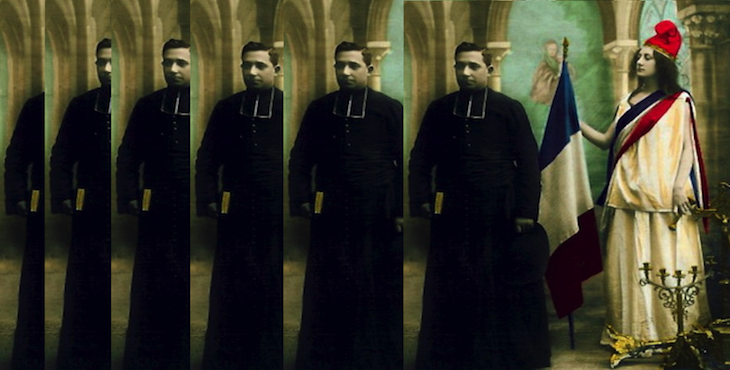Against Principles
Constantine Sandis argues for a holistic approach to museums
When leaving Athens, don’t buy ouzo at the Duty Free. The aperitif is divine when poured over ice under the Attic sun, but largely disagreeable in rainy England. This rather simple observation, that cultural artefacts have varying effects in the context of different locations and the moving populations around them, is seriously downplayed within cultural heritage debates appealing to moral and museological principles. I stand against the grain, advocating that we shouldn’t prescribe any general rules determining the location in which cultural artefacts whose ownership is contested ought to be housed. As populations, identities, and technologies shift with unprecedented velocity, debates regarding the ownership of antiquity are fast becoming antiquated, while the question of where and how they should be exhibited—if indeed they should be exhibited at all—has never been so timely.
Consider an artefact still in its teenage years: the 2001 Throne of Weapons sculpture by Cristóvão Canhavato (Kester), featured in Neil Macgregor’s A History of the World in a Hundred Objects. Kestor’s throne is composed of decommissioned weapons from the fifteen-year Mozambican civil war and was specially created for Mozambique’s Transforming Arms into Tools project. But it can also be approached from within the wider context of African art, in which non-figurative objects such as chairs, stools, and pots are portrayed as human beings, as well as the older wood carving tradition, in which termites are said to leave their ‘signature’. It acquires additional significance when encountered as a work of Western conceptual art, signed by the artist under one of the readymade AK-47s (none of which were manufactured in Africa).
The Throne of Weapons has been exhibited across the world in museums, community and shopping centres, cathedrals, popular music concerts, youth forums, government offices, and prisons Similarly, Algot Lange’s ‘Livingstone Medicine Chest’, from his 1911 Amazon expedition, has been displayed as part of different exhibitions at Kew Gardens, the Wellcome Collection, Science Museum, Hornimam Museum, and the Natural History Museum. In each new context, the artefacts form part of a different narrative, bestowed with new significance. Conversely, every space may itself be transformed by the inclusion or exclusion of a single object (such as the statue of Cecil Rhodes at Oriel College, Oxford) or even a mere part of one (as we must recognize the head of the horse of Selene, from the east pediment of the Parthenon, to be). Then there are installations—such as those of Jason deCaires Taylor’s underwater sculptures—that altogether subvert the curatorial distinction between exhibited artefact and form of exhibition.
The sort of meaning in question is here deeply intertwined with meaningfulness. In his book The Mess Inside: Narrative, Emotion and the Mind, Peter Goldie suggests that narratives may be connected to two different kinds of meaningfulness: internal and external. The first reveals something about whomever (and, by my current extension, whatever) the narrative is about. The second tells us something about the narrator herself. Setting aside how sharp a divide can be marked between such things, I wish to discuss a third domain of meaningfulness, one that pertains to the receiver of the narrative. Within museology, the external/internal divide is further complicated by the insertion of curatorial narrators who stand between the original craftsperson and the exhibition visitor. Just as the author cannot control the meaning of her works, so too the curator cannot impose it.
In a 2004 Guardian article entitled ‘The Whole World in Our Hands‘ Macgregor uses Kestor’s throne as an example of how large, encyclopaedic museums are uniquely equipped to deal with such multiplicities of meaning:
When we look at the arms-chair, we realise we are looking at guns made in Britain, Europe, the US. It’s a potent emblem, I think, of the complexities linking Africa to the rest of the world […] I don’t know where else a visitor can apprehend Africa in so many contexts. A collection that embraces the whole world allows you to consider the whole world. That is what an institution such as the British Museum is for.
What is the reasoning behind such grand claims? James Cuno, President and CEO of the J. P. Getty Trust, explicitly contrasts encyclopaedic museums to national ones in his book Museums Matter: In Praise of the Encyclopaedic Museum. But this juxtaposition is highly misleading, at best. National museums may be universal or encyclopaedic in their scope, encyclopaedic museums may be nationalistic or colonial in intention, and local museums may be truly cosmopolitan, a word that Cuno cheekily uses interchangeably with universal and encyclopaedic. This is curatorship by rhetoric. The appropriate contrast to universal here is specialist, and a specialist museum need not be nationalist, anymore than a special exhibition on, say, the history of the drum, need restrict itself to one nation.
In their defences of ‘universal’ encyclopaedic museums, Macgregor and Cuno are effectively treating museums as three-dimensional walk-in books. But a museum is not a book of any kind. If one wants encyclopaedic knowledge, one should consult an encyclopaedia. Museums, by contrast, offer the public a chance to come close to the past and experience that wondrous thrill from the thought (true or otherwise) of being in direct proximity with the objects from past worlds. This is not to deny that museums can and should educate. But museums have a plurality of purposes, and this particular one is better served by open-access digital archives and casts or replicas that can be touched, moved, examined, and photographed without risk.
The universalist stronghold of MacGregor and Cuno has recently been challenged by defenders of a more communitarian approach that seeks to replace the learning museum with the museum of social conscience, thereby addressing the competing interests of different communities. Their voices have been collected in Laura Peers and Alison K. Brown’s Museums and Source Communities and Viv Golding and Wayne Modest’s Museums and Communities. Such outlooks call for a shared authority of ‘fully collaborative and polyvocal practices’ of museums working with communities ‘in non-tokenistic ways that bestow equal respect’. These range from the sort of consultations that helped the redevelopment of Manchester Museum’s Ancient Egypt Gallery to deeper collaborations, such as those involved in the 2007 Bicentenary of Britain’s Abolition of the Slave Trade and the Migration Memories exhibition in Canberra.
There is no doubt that biographies of objects interlock with those of multiple communities. Psycho-geographical considerations suggest that moving an object, such as one of the many Pillars of Ashoka, from Bloomsbury to Hounslow may have a greater impact in its reception than moving it from anywhere in London to, say, the 1st arrondissement of Paris. Objects need not themselves move for their impact and significance to change. It is sufficient for a community to move around them. Consider repatriation claims based on the cultural significance of any given artefact. When a large part of the community whose heritage this relates to migrates to the area in which the object is housed, this inevitably affects the question of whether it should still be repatriated.
Such issues reveal the emptiness of the ‘who owns culture?’ debates that consistently pit defenders of universal museums against those who claim all cultural artefacts ought to be returned to their place of origin. There cannot be any helpful hard-and-fast rules determining the location of objects whose provenance is a matter of controversy. Decisions should instead be made on a case-by-case basis, considering a wide range of reasons: moral, aesthetic, educational, distributional, legal, historical, pragmatic, and psycho-geographical. No principle is so high that it alone can settle the question of where any single cultural artefact should be located, let alone all. A corollary of this holistic conclusion is that it is not as easy for precedents to be set as some museum experts and defenders of ‘heritage’ in the abstract allege. No floodgates would be opened if the Parthenon sculptures were to be rightly re-unified under one Athenian roof, or the statue of Cecil Rhodes to at long last fall from Oriel College, any more than they were when Jesus College, Cambridge removed its Benin bronze cockerel last year. The damage done by holding onto principles in museology is as great as the gains to be had by freeing ourselves from them.
The Source Code
This essay is based on the book Cultural Heritage Ethics: Between Theory and Practice edited by Constantine Sandis (Open Book Publishers, 2014).






